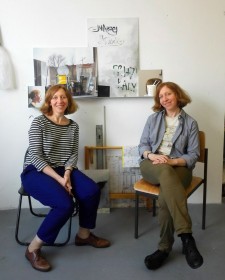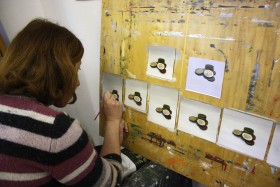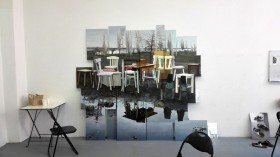A Conversation with the Artists Maria und Natalia Petschatnikov
The end of May, as the first palpable rays of sun shone in Berlin, offered the perfect occasion for an outing to Berlin’s Kreuzberg neighborhood. There the artists Maria and Natalia Petschatnikov showed me their atelier and told me about “Sparrows” and “4 Euros,” the two objects they made for the Jewish Museum Berlin’s art vending machine. They also talked about their current projects and responded with good humor to all of my questions above and beyond the subject of art.

Maria (left) and Natalia Petschatnikov in front of part of their project “Berlin & Berlin”, 2015
© and photo by Michaela Roßberg
Michaela Roßberg: You work together and you’re twins – identical twins. What is it like to work so closely? How do you develop ideas and work on projects? And does one or the other of you start with an image of the finished work in mind?
Maria: We do a lot through dialogue. It isn’t that one of us has an idea and, once a project is finished, could say: “That was my idea.” Our work emerges from a joint process. For instance, we walk through the city and see interesting things that get us thinking. We talk about them, and together, start forming ideas.
Natalia: The urban environment is something that frequently inspires us. Because we spend a lot of time together in observation, a lot of our work features the so-called little things of everyday life, like animals or public transportation.
What did you think when the Jewish Museum Berlin asked you about participating in the new series for the art vending machine? Why did you decide to do it?
Natalia: First of all, we have a lot of respect for the institution of the museum. But also, the project gives us the chance to tell something about ourselves and our work. We produced 400 objects for the vending machine, which means that hopefully we are reaching 400 people with our art. The feeling that you reach people with your own work is very important for artists.
Maria: We find the idea very good, as well. Art is often elitist: we can’t afford our friends’ work and they can’t afford ours. The great thing about the art vending machine is that it builds a lovely bridge between art and the museum’s visitors. We don’t make a distinction between our work for 4 euros or 400 euros. We put the same effort into both. In addition, the appreciation and respect for us as artists was pleasing, along with the impressive amount of effort the people in charge of the project made, even though the works only cost 4 euros.
Normally an artist produces one, or perhaps a few, pieces of one artwork, not 200, as for the art vending machine. Doesn’t the sheer quantity get frustrating at some point?

Maria at work on the project “4 Euros” for the art vending machine
© and photo by Natalia Petschatnikov
Natalia: On the contrary, as you work on multiple pieces from the same model, your connection to the work changes. You start to play with it; you experience it differently.
Even when it’s the 150th time?
(Both laugh)
Maria: It went really well with the “Sparrows” for the vending machine because we cast them. It was a lot of work, but not as much work as the paintings. But then even with the “4 Euros” paintings, we had specific reasons for them: there was a conceptual level to them. For us that was really a commentary on what’s happening in our field. Who decides how much a work of art is worth? Who does the appraisal?
Natalia: So museum visitors will get a piece of art by us that costs 4 euros, and for this 4 euros, they receive 4 euros back, only now as a painting that shows the coins.
Together with every object in the art vending machine there’s a leaflet with information about the artists and the ideas behind the works. Accompanying yours, we read that – in your opinion – small things often reflect larger social and historical tendencies. I find that fascinating. Could you talk more about that?
Natalia: You can see the way this works in Berlin in particular with, for instance, public transportation like the tram. There haven’t been trams in West Berlin since the 70s because they were considered too loud, a disturbance. In the East though, the network of trams was extensively developed. After reunification, people noticed that the tram significantly improves the quality of life because you can get through city traffic much more easily by tram and it’s more environmentally friendly. Now the tram network is being expanded.
Maria: Or simply coffee-to-go. Not even in German, “zum Mitnehmen”, but “to go”. How have people or society itself developed such that suddenly we want to drink our coffee while moving? Why did no one think of that before – to walk down the street with his coffee in his hand? People used to sit quietly somewhere to drink their coffee.
We try to carve out the remarkable little things that could seem trivial, but that we think demonstrate such tendencies. Like archeologists or anthropologists, we try to render these things perceptible. Imagine what will happen when someone finds a coffee-to-go cup hundreds of years from now. Researchers will probably try to draw conclusions about the society of 2015 from objects like these.

The work “Mauerpark” from the project “Berlin & Berlin,” 2015. Oil on polyester leaf, Aludibond
© and photo by Michaela Roßberg
What are you working on at the moment? Is that a detail from the flea market at Berlin’s Mauerpark? At any rate I recognize the Jahn Stadium, being a soccer fan.
Natalia: Yes, we saw exactly this scene that you see on the wall, at the flea market. We took a photograph and then painted it in oils on a lot of little metal plates. We found the old pieces of furniture being sold there fascinating, together with their reflections in the puddles on the ground around them.
Maria: The work is part of a project called “Berlin & Berlin”. We showed this installation consisting of paintings and objects at the German Week in St. Petersburg last April. We find flea markets so interesting because they offer a likeness of society at this very moment and they bring so many things together that would never otherwise be together. Such as a Barbie doll with a Russian nesting doll. Both are emblematic of different worlds but now they’re for sale in the same box.
Most of your works have to do with Berlin. What does the city mean to you?
Maria: We try to investigate each place we live on a visual level. Berlin is special though: I find that this city has unbelievably many levels. They aren’t all happy or funny, but the deeper you go, the more stories open up.
Natalia: We aren’t politicians or historians. We observe the world on a different level, the visual one. When we moved here, it was clear that we needed to live in the East.
Maria: After reunification the Eastern part of the city was more exciting for artists and young people, much cheaper, and it offered more possibility. A lot of houses for artists emerged and people were able to found new galleries. We still feel this energy. But now we’re starting to discover West Berlin. You can find exciting angles on history and great places for art there. So – we will always have material for new projects in Berlin.
During the three-hour interview Michaela Roßberg not only learned a lot about artists in Berlin, but also received some excellent travel tips for St. Petersburg and Moscow.
P.S.: Further information about the artwork of Maria and Natalia Petschatnikov and the other artists of the art vending machine can be found here.